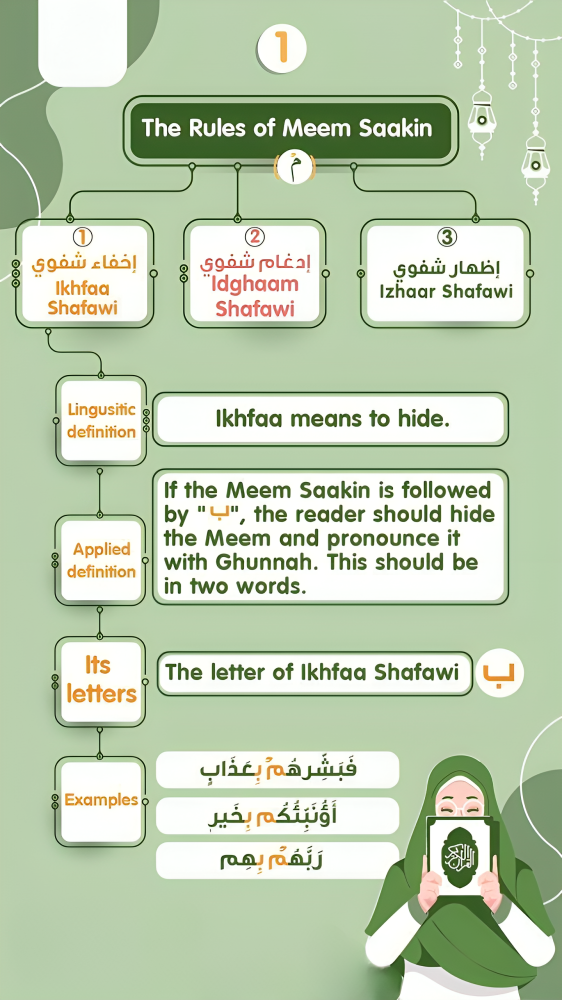Full-Mouth Letters
In the beautiful recitation of the Quran, every letter carries its unique characteristics and pronunciation rules. Among these are the “full-mouth letters” (الحروف المستعلية – Al-Huroof Al-Musta’liyah), which play a crucial role in proper Quranic recitation. Let’s explore these letters and their importance in Tajweed.
What Are Full-Mouth Letters?
Full-mouth letters, or Huroof Musta’liyah, are those letters whose pronunciation requires the back of the tongue to rise towards the upper palate. There are seven full-mouth letters in Arabic, commonly remembered through the phrase “خُصَّ ضَغْطٍ قِظْ” (Khussa Daghtin Qiz).
The seven letters are:
- خ (Khaa)
- ص (Saad)
- ض (Daad)
- غ (Ghayn)
- ط (Taa)
- ق (Qaaf)
- ظ (Zhaa)
Characteristics of Full-Mouth Letters
1. Elevation (الاستعلاء)
- The primary characteristic is the elevation of the back of the tongue toward the upper palate
- This elevation gives these letters their full, heavy sound
- The sound resonates in the upper mouth cavity
2. Degrees of Heaviness
Not all full-mouth letters share the same degree of heaviness. They can be categorized into three levels:
Strongest:
- ط (Taa)
- ض (Daad)
- ص (Saad)
- ظ (Zhaa)
Medium:
- ق (Qaaf)
Lighter:
- خ (Khaa)
- غ (Ghayn)
Rules for Reciting Full-Mouth Letters
1. Basic Pronunciation Guidelines
- Maintain the elevation of the tongue for the entire duration of the letter
- Avoid making the sound thin or light
- Keep the mouth slightly open during pronunciation
- Ensure proper emptiness in the mouth cavity
2. Special Considerations with Vowels
When full-mouth letters appear with different vowels (harakaat), observe the following:
With Fathah (فتحة):
- The sound becomes more open and full
- Example: طَ is pronounced with clear heaviness
With Dammah (ضمة):
- Maintain roundness of lips while keeping the heaviness
- Example: قُ requires both lip rounding and tongue elevation
With Kasrah (كسرة):
- The heaviness is slightly reduced but must still be maintained
- Example: صِ should not become thin like سِ
3. Common Mistakes to Avoid
- Making the letters too light (tarqeeq)
- Exaggerating the heaviness beyond natural limits
- Losing the heaviness when the letter carries a kasrah
- Neglecting the heaviness when the letter is sakin (having sukoon)
Practical Tips for Improvement
- Listen to Expert Reciters
- Study recordings of qualified Qurra
- Pay attention to how they maintain the fullness of these letters
- Practice mimicking their pronunciation
- Regular Practice
- Start with individual letters
- Progress to words containing these letters
- Finally, practice in complete verses
- Record Yourself
- Make recordings of your recitation
- Compare with expert recitations
- Identify areas needing improvement
Conclusion
Mastering the pronunciation of full-mouth letters is essential for proper Quranic recitation. Regular practice, attention to detail, and guidance from qualified teachers will help develop proper pronunciation. Remember that these rules weren’t created to make recitation difficult but to preserve the authentic pronunciation of the Noble Quran as revealed to Prophet Muhammad (peace be upon him).
Additional Resources
For further learning and practice:
- Seek guidance from a qualified Quran teacher
- Use reputable Tajweed apps and resources
- Join Tajweed study circles in your local mosque
- Practice with online Tajweed courses
Note: This article serves as an introduction to full-mouth letters. For proper Tajweed learning, it’s essential to study under a qualified teacher who can provide direct feedback and correction.





